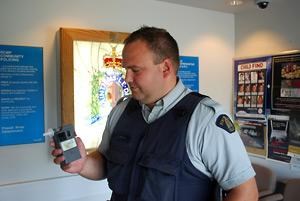Back in the 1920s, the word prohibition—at least when pertaining to alcohol—had a very different meaning than it does today. Those were the days of rumrunners, bootleggers and the speakeasies they used to supply for a pretty penny. While the laws have changed since then and liquor has now become legal for persons of the right age, driving after consuming too much of it has not. Prohibitions in that regard are likely to cost more than any night at the bar ever could, according to a breakdown of associated expenses released in July 2012 by the Province of BC for the Ministry of Justice.
Imagine this scenario. You’re at the pub, you have a few drinks, you determine by your own judgement that you’re likely still okay to drive and you head to your car. After a kilometre or two you come to a roadblock where an RCMP officer smells alcohol on your breath and asks you to blow into a roadside screening device. It reads a 0.06 blood-alcohol level, which, believe it or not, just cost you about $600. How? Here’s how:
Under the BC Motor Vehicle Act, police are permitted to issue roadside suspensions, impound cars and levy fines in the hundreds of dollars for drivers with a blood-alcohol level of 0.05 or higher. Being over that limit, your car will be towed and impounded for three days, at the officer’s discretion, for a cost of approximately $150. You then face $200 in administrative penalties and a $250-licence reinstatement fee in trying to get it and your driver privileges back.
And that’s just your first warning. Your second, if by chance you encounter the same situation within five years of your first, will cost you a total of $780 on account of additional administrative fees and the extra costs associated with impounding your vehicle for seven days instead of three.
The third warning within a five-year period is most expensive of all. Your driving prohibition length is then increased to 30 days and your vehicle impounded for that entire duration at a cost of $680 or more. Administrative penalties increase to $400 and a licence reinstatement fee remains at $250. Enrollment in a responsible driver program is mandatory at a cost of $880 and an ignition interlock device will be installed in any vehicle you drive for a one-year period. It costs over $1,730 to install and monitor and requires that you blow within the legal limit before your vehicle will start. Depending on the results it records over those 12 months, additional months may be added at a cost of $105 each, on top of the $3,940 in total fees that come with this third warning.
“[A warning is] not in the criminal realm of things but under the Motor Vehicle Act they want you off the road and that’s where you run into the immediate roadside prohibition (IRP),” said Constable Chris Bakker of Powell River RCMP.
Penalties get tougher for an outright fail, considered to be anything over the 0.08 level.
The driving prohibition length then increases to 90 days, your vehicle is impounded for 30 and you are required to enroll in the responsible driver program. An ignition interlock device is installed in this case as well and administrative fees increase to $500 for a total of $4,040 or more. And, as with most things in life, refusing to even try is as good as failing. Withholding a breath sample will yield the same result, cost and penalties as blowing over 0.08.
But it doesn’t stop there. Depending on several factors, you may be charged under the Criminal Code of Canada for a fail reading, which will cost considerably more due to legal fees. “If you’re over 0.08 we have the discretion to either provide you an IRP or we can go Criminal Code,” said Bakker. “If there’s a collision or if you’ve got one or two of these in the last five years then we’re going to go Criminal [Code] so you’re going to go to court and you’re going to be charged with impaired driving.”
Since the laws toughened up on September 20, 2010, alcohol-related motor vehicle deaths have gone down significantly in BC. “Compared to the average over the previous five years, [they] have dropped by 44 per cent since the law came into force—with an estimated 71 lives saved,” said a statement released by the ministry. That law was amended on June 15 of this year to ensure all drivers who blow above the warning level will be given a second breathalyzer test on a more specialized device.
Bakker said the laws and penalties, while certainly tough, are beneficial and are accomplishing exactly what they were intended to do. “People are starting to think twice before they drive,” he said, “and if [a large fine] makes people think twice about having that third, fourth, maybe fifth drink, or second even depending on what they’ve eaten, then that’s what it’s there for. A taxi ride is $20 and if you get caught it’s going to be $4,000 [in some cases]. It’s a common sense answer, right?”



